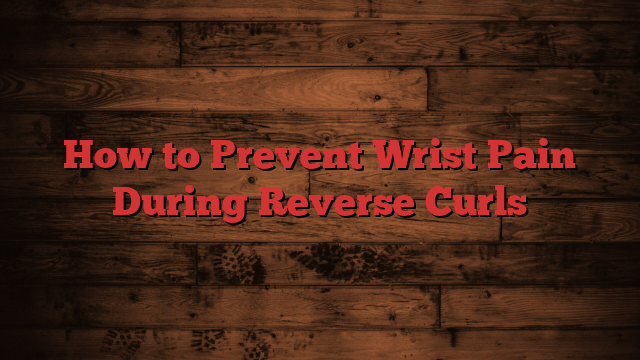Have you ever experienced wrist pain while doing reverse curls? It can be frustrating when a simple exercise like reverse curls becomes uncomfortable or painful.
But don’t worry, in this article, we will discuss the common causes of wrist pain during reverse curls and provide you with some helpful tips to prevent it. So, let’s dive in and discover how you can make your reverse curl workouts pain-free!
When it comes to reverse curls, one of the main reasons why you may experience wrist pain is due to improper technique. Many people tend to grip the bar too tightly, which can put unnecessary strain on the wrists.
To prevent this, it’s important to maintain a relaxed grip on the bar and let your wrists remain in a neutral position. Additionally, it’s crucial to avoid bending your wrists too much during the exercise. This can lead to excessive pressure on the joint, leading to pain.
By keeping your wrists straight and in line with your forearms, you can minimize the stress on your wrists and reduce the risk of pain or injury. These are just a few of the tips we will discuss in more detail in the upcoming article. So, if you want to learn more about how to prevent wrist pain during reverse curls, keep reading!

Understanding Reverse Curls
What are Reverse Curls?
Reverse curls are a popular strength training exercise that target the muscles in your forearms and biceps. Unlike traditional bicep curls where you grip the bar with an overhand grip, reverse curls involve gripping the bar with an underhand grip, with your palms facing down. This variation of the exercise places more emphasis on your brachialis and brachioradialis muscles, which can help improve the overall strength and appearance of your forearms.
Benefits of Reverse Curls
Reverse curls offer a range of benefits, including:
- Increased forearm strength: Reverse curls specifically target the muscles in your forearms, helping to improve grip strength and forearm size.
- Enhanced bicep development: By targeting both your biceps and forearms, reverse curls can help improve the overall development of your upper arm muscles.
- Improved wrist stability: The stabilizer muscles in your wrists and forearms are engaged during reverse curls, leading to improved wrist stability and reduced risk of injury.
Causes of Wrist Pain during Reverse Curls
While reverse curls can be an effective exercise, some individuals may experience wrist pain during or after performing the exercise. This can be caused by a variety of factors, including:
Incorrect Grip Technique
Using an improper grip technique, such as gripping the bar too tightly or not aligning your wrists properly, can place excessive strain on your wrists, leading to pain and discomfort.
Lack of Proper Warm-up
Failing to warm up adequately before performing reverse curls can increase the likelihood of experiencing wrist pain. Proper warm-up exercises can increase blood flow to the wrist, improve joint mobility, and activate the stabilizer muscles.
Overloading or Using Heavy Weights
Lifting weights that are too heavy for your current strength level can put unnecessary stress on your wrists, leading to pain and potential injury. It is important to select an appropriate weight that challenges you without compromising your form or wrist stability.
Limited Range of Motion
Performing reverse curls with a limited range of motion, such as not fully extending your wrists at the bottom of the movement or not allowing them to flex fully at the top, can cause discomfort and wrist pain.

Proper Grip Technique to Prevent Wrist Pain
Using the correct grip technique during reverse curls can help alleviate wrist pain and prevent injury. Here are some tips to ensure proper grip technique:
Use an Underhand Grip
When performing reverse curls, grip the barbell with an underhand grip, with your palms facing down. This grip helps to engage the muscles in your forearms and reduces the strain on your wrists.
Place Wrists in a Neutral Position
Ensure that your wrists are in a neutral position throughout the exercise. Avoid excessive flexion or extension of the wrists, as this can strain the joint and cause discomfort.
Avoid Excessive Wrist Flexion or Extension
Maintain a straight line from your forearm to your hand, avoiding any excessive bending or curving of the wrists. This will help distribute the weight evenly and reduce stress on the wrists.
Ensure Firm Hold on the Barbell
Hold the barbell firmly, but avoid gripping it too tightly. Find a balance where you have control over the weight without placing excessive pressure on your wrists.
Benefits of Proper Warm-up
Warming up before performing reverse curls is essential in reducing the risk of wrist pain. Here are some benefits of incorporating a proper warm-up routine:
Increased Blood Flow to the Wrist
A thorough warm-up routine, including wrist mobility exercises, increases blood flow to the wrists, delivering essential nutrients and oxygen to the muscles, tendons, and ligaments. This promotes flexibility and reduces the risk of injury.
Improved Joint Mobility
Warm-up exercises that focus on wrist mobility help to loosen up the joints, enhancing their range of motion. This allows for a smoother and more comfortable execution of reverse curls.
Activation of Stabilizer Muscles
An adequate warm-up routine activates the stabilizer muscles around the wrists and forearms, allowing them to support the weight during reverse curls. This helps improve overall wrist stability and reduces the chances of pain or injury.

Importance of Appropriate Weight Selection
Selecting an appropriate weight for reverse curls is crucial to prevent wrist pain. Here are some tips to consider:
Gradually Increase Weight as Strength Improves
When starting reverse curls, begin with a weight that challenges you without causing excessive strain on your wrists. Gradually increase the weight as your strength improves to avoid overloading your wrists too quickly.
Avoid Overloading the Wrist
Never lift weights that are beyond your current capabilities. This places excessive stress on your wrists and increases the risk of pain and injury. Choose weights that allow you to maintain proper form and technique throughout the exercise.
Consider Using Wrist Wraps for Added Support
If you have a history of wrist pain or feel that your wrists need extra support during reverse curls, consider using wrist wraps. Wrist wraps can provide additional stability and reduce the strain on your wrists.
Exercises to Improve Wrist Strength and Flexibility
Incorporating specific exercises to strengthen and improve the flexibility of your wrists can help reduce pain during reverse curls. Here are some exercises to consider:
Wrist Curls
Performing wrist curls with light dumbbells or a barbell can help strengthen the muscles and tendons in your forearms and wrists. Start with a comfortable weight and gradually increase over time.
Wrist Flexor and Extensor Stretches
Stretching the muscles in your wrists and forearms before and after your workout can improve flexibility and reduce the risk of injury. Simple stretches, such as wrist extension and flexion, can be done by holding a weight and gently moving the wrist joint.
Finger Push-ups
Engaging in finger push-ups places emphasis on the muscles in your hands, wrists, and forearms, helping to improve strength and stability. Start on your knees or a flat surface and gradually progress to full push-ups on your toes.

Tips for Proper Range of Motion
Performing reverse curls with proper range of motion can prevent wrist pain and ensure optimal results. Consider the following tips:
Start with a Wider Grip
Begin with a wider grip when performing reverse curls to allow for a more comfortable range of motion. As your wrist strength and flexibility improve, gradually narrow your grip to target the muscles more effectively.
Avoid Excessive Lowering of the Barbell
When performing reverse curls, avoid lowering the barbell too far below your wrists. This can strain the wrists and lead to discomfort or pain. Lower the barbell to a point where your wrists are still in a neutral position.
Maintain Control throughout the Movement
Maintain control over the weight throughout the exercise to avoid jerky movements or sudden drops that could stress the wrists. Slow, controlled movements will not only reduce the strain on your wrists but also maximize muscle activation.
Importance of Rest and Recovery
Rest and recovery are vital to prevent wrist pain and promote overall muscle health. Here’s why it’s important:
Allow Sufficient Time for Wrist Recovery
Give your wrists ample time to rest and recover between workout sessions. Overtraining or not allowing enough time for recovery can lead to chronic wrist pain and increased risk of injury.
Incorporate Rest Days into Your Workout Routine
Include regular rest days in your workout routine to give your wrists and body a chance to recover. Rest days allow for tissue repair and muscle growth, contributing to overall strength and performance.
Apply Ice or Heat Therapy as Needed
If you experience acute wrist pain after performing reverse curls, applying ice or heat therapy can help reduce inflammation and alleviate discomfort. Ice can be applied immediately after your workout, while heat therapy can be used later on to promote blood flow and relaxation.

Seeking Professional Guidance
If you consistently experience wrist pain during reverse curls, it may be beneficial to consult with a fitness trainer or physical therapist. They can assess your technique and form, provide personalized recommendations, and develop a plan to address your wrist pain.
Consulting with a Fitness Trainer or Physical Therapist
A fitness trainer or physical therapist can guide you through proper form and technique, ensuring that you are performing reverse curls correctly to minimize the risk of wrist pain.
Getting an Expert Opinion on Technique and Form
An expert opinion can help identify any flaws in your technique or form that may be contributing to your wrist pain. They can offer specific modifications or exercises to address your individual needs.
Conclusion
By following proper technique, warm-up strategies, weight selection, and incorporating specific exercises, you can prevent wrist pain during reverse curls. Prioritizing rest, recovery, and seeking professional guidance when needed will help you maintain a healthy and pain-free workout routine.
Remember, taking care of your wrists is key to achieving optimal results and preventing long-term injuries. So, go ahead and make the necessary adjustments to protect your wrists while reaping the benefits of reverse curls!




